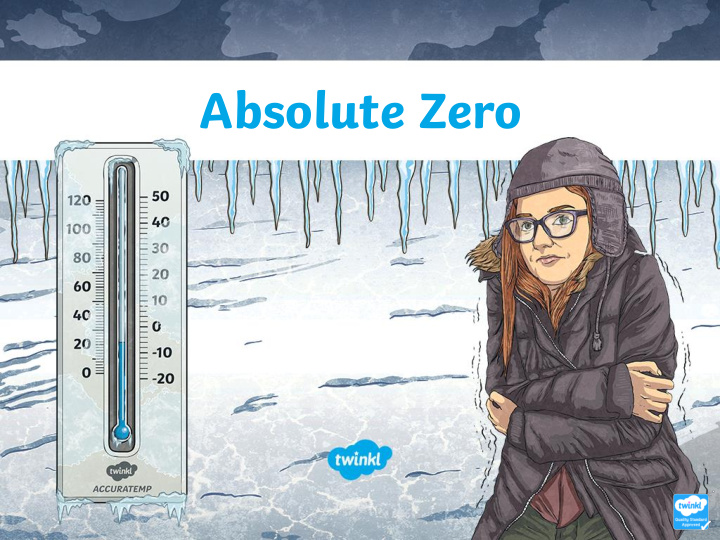



Absolute Zero
Aim Aim • I can explain what Lord Kelvin called ‘absolute zero’. • I can accurately use a thermometer. Success Criteria Success Criteria • Statement 1 Lorem ipsum dolor sit amet, consectetur adipiscing elit. • I can describe Lord Kelvin’s life and work. • Statement 2 • I can make a model to demonstrate how particles behave at absolute zero. • Sub statement • I can use a thermometer to read and show temperatures.
Searching for Absolute Zero How cold can it get? This is a question that had puzzled scientists for hundreds of years in the 17 th , 18 th and 19 th centuries. They wondered if there was a limit to how cold things could possibly get. Many scientists joined in the race to find 'absolute zero' – the lowest temperature possible. Ideas ranged from French physicist Guillaume Amontons' suggestion of -240 C, to English scientist John Dalton's proposal of -3000 C. It was not until 1848 that the question was finally answered and Lord Kelvin discovered the coldest possible temperature, the absolute zero.
Lord Kelvin Lord Kelvin was born in Ireland in 1824. He was named William Thomson, but he became better known as Lord Kelvin in later life. When Thomson was eight, his father moved to Glasgow in Scotland to teach at the University of Glasgow. At the age of ten, Thomson passed the entrance exams for the university and began studying there. Although he was very young, he kept up with the other students and studied complex ideas.
Lord Kelvin In 1841, he attended Cambridge University and in 1846, he went back to the University of Glasgow, this time as professor of natural sciences. He held this post for over fifty years! While there, he created the first physics laboratory in Britain . Thomson became interested in the work of James Joules and Nicolas Carnot, who had both published their separate research into heat and energy. Their ideas led Thomson to develop his temperature scale and find absolute zero.
Lord Kelvin In recognition of his discovery, Thomson was made a Lord in 1892. He was named Lord Kelvin after the River Kelvin, which flowed near his lab in Glasgow. He worked on many other inventions, including supervising the laying of the first telegraph cables under the Atlantic in the 1850s and 1860s. He also developed a sailor's compass and invented several electrical devices. His house in Glasgow was the first to be lit by electric light. The Hunterian Museum at Glasgow University has a permanent exhibition of Kelvin's life and work.
True or False? Are these statements about Lord Kelvin true or false? Talk with your partner, then look at the next slide to reveal the answers. He attended university when he His house in Glasgow was the was just ten years old. first to have a telegraph machine. He created the first physics Lord Kelvin found the laboratory in Britain. temperature called absolute zero. He was named William Kelvin He was born in when he was born. Glasgow, Scotland. Can you correct the false statements?
True or False? Are these statements about Lord Kelvin true or false? Talk with your partner, then look at the next slide to reveal the answers. He attended university when he His house in Glasgow was the was just ten years old. first to have a telegraph machine. He created the first physics Lord Kelvin found the laboratory in Britain. temperature called absolute zero. He was named William Kelvin He was born in when he was born. Glasgow, Scotland. Can you correct the false statements?
Absolute Zero Lord Kelvin developed a temperature scale called the Kelvin scale. His research into heat and energy allowed him to determine the temperature of absolute zero. This is the coldest possible temperature. He found that it was -273.15 C . At this temperature, all the particles in a material would almost stop moving completely At the moment, scientists do not have the ability to cool materials down to absolute zero, although a method called laser cooling can produce temperatures extremely close to absolute zero. At these temperatures, some materials develop unusual properties, such as superconductivity, which is where a material becomes a special type of electrical conductor. The lowest natural temperature ever recorded is around -272 C, in the Boomerang Nebula, a star system about 5000 light years away from Earth.
Particle Model Use marbles to demonstrate how the particles in a material change their behaviour as they cool down and eventually reach absolute zero.
Scales of Temperature Lord Kelvin created a new temperature scale to show absolute zero. It is called the Kelvin Scale, and it is measured in kelvins, not degrees Celsius. This thermometer shows Kelvin's scale next to the more familiar Celsius scale. You can use the Celsius scale to convert temperatures to the Kelvin scale. Look at -273 C on the Celsius side. Now, follow the line across the thermometer to the Kelvin side. You can see it shows zero. So -273 C is Can you convert the temperatures on your Scales of the same as Temperature Activity Sheet using both sides of the 0 Kelvin. thermometer?
What Have You Learnt? Tell your partner three things you have learnt today. Include one thing about Lord Kelvin, one thing about absolute zero and one thing about how particles move at different temperatures.
Aim Aim • I can explain what Lord Kelvin called ‘absolute zero’. • I can accurately use a thermometer. Success Criteria Success Criteria • Statement 1 Lorem ipsum dolor sit amet, consectetur adipiscing elit. • I can describe Lord Kelvin’s life and work. • Statement 2 • I can make a model to demonstrate how particles behave at absolute zero. • Sub statement • I can use a thermometer to read and show temperatures.
Recommend
More recommend